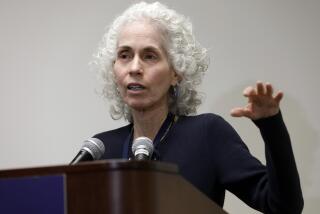PERSPECTIVE ON URBAN AMERICA : Countyâs Health Care Crisis
The ice surrounding national health-care reform finally seems to be cracking. The President-elect has made it a top priority, calling for universal health coverage, a basic set of benefits and new measures to control costs. Two weeks ago, an important segment of the health insurance industry backed similar proposals.
Fundamental reforms of this sort would bring a measure of relief to communities struggling to maintain tattered safety nets under 35 million uninsured Americans. But Washingtonâs wheels grind slowly. And as RANDâs new book, âUrban America: Policy Choices for Los Angeles and the Nation,â and the recent report of the Los Angeles County Task Force on Health Care Access make clear, our local public health system is near collapse. There are urgent, do-it-ourselves repairs to be made.
One statistic casts the problem in sharp relief: Los Angeles County has the highest proportion of uninsured residents of any major metropolis--33%, roughly double the national average. Some 2.7 million uninsured people depend on the services of county-operated hospitals and clinics and the charity of a patchwork of privately funded free clinics, hospitals and physicians.
The problem is not confined to the indigent. Nearly nine out of 10 of the uninsured are jobholders and their dependents whose employers do not provide health coverage.
Uninsured individuals receive both less and lower quality medical care than the rest of us, raising their risks and the communityâs costs. Letting a problem go usually leads to more extensive and expensive care down the line.
Our task force estimated that 4 million to 5 million additional doctor visits a year are needed simply to meet basic health needs of the uninsured here. This would require a doubling of county services--not a realistic prospect in a budget crisis.
Draconian remedies have been proposed--taxing hospitals that donât give free care in order to compensate hospitals that do, requiring doctors to work pro bono--but suggestions such as these are only the measures of our desperation. Other means are available, notably the more efficient use of local resources.
First, the county should coordinate all services, public and private, to create a single system of managed care for the uninsured. The place to start is with the countyâs own sprawling network. At present, its six hospitals and 46 health centers lack effective means of coordinating patient care. A computer-based referral system should be created so that patients can be moved efficiently through the public and private health-care labyrinth. For example, emergency rooms currently do not have efficient procedures for referring patients to clinics where care can be provided at lower cost.
The county should make better use of retired physicians, nurses and other volunteers, including finding space for them in clinics and covering their malpractice insurance costs. The use of supervised physician assistants could be expanded to reduce waiting times in emergency rooms.
Volunteer partnerships should be formed by managed-care firms, physician groups and others to support and staff private, free and community clinics.
Why is it important to take these steps? One reason is that the prevailing Robin Hood system of health-care finance forces doctors and hospitals to pad the bills of insurance premiums for the rest of us and disguise the true cost of caring for the poor.
But even this inefficient expedient is threatened by the growing strength of the managed-care movement. There isnât much slack for fee-shifting when providers offer discounts to attract patients, and everyone is keeping an eagle eye on costs. As this source of funding dries up, cracks in the system will widen, and more of the needy will be turned away.
Another reason for concern is that the emergency facilities on which we all depend are being driven under by the costs of caring for the growing legions of the poor. Of 103 licensed emergency rooms in the county in 1982, 85 remain; the number of trauma centers dwindled from 23 to 13.
Finally, the re-emergence of measles and tuberculosis as public-health threats and the growing incidence of other contagious diseases should alarm us all. This is what happens when the poor go without vaccinations, screening and other basic forms of health care.
Strategies for coordinating, reorganizing and stretching our resources are the splints and bandages that will keep our public health system alive, if not well, for now. As for the rest, âCalling Dr. Clinton.â
More to Read
Sign up for Essential California
The most important California stories and recommendations in your inbox every morning.
You may occasionally receive promotional content from the Los Angeles Times.










